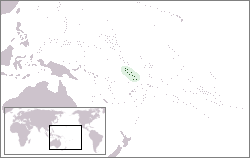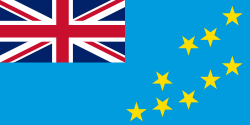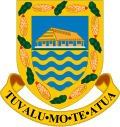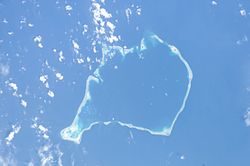

The following outline is provided as an overview of and topical guide to Tuvalu:
Contents
- General reference
- Geography of Tuvalu
- Environment of Tuvalu
- Regions of Tuvalu
- Demography of Tuvalu
- Government and politics of Tuvalu
- Branches of the government of Tuvalu
- Foreign relations of Tuvalu
- Law and order in Tuvalu
- Military of Tuvalu
- Local government in Tuvalu
- History of Tuvalu
- Culture of Tuvalu
- Art in Tuvalu
- Sports in Tuvalu
- Economy and infrastructure of Tuvalu
- Education in Tuvalu
- Infrastructure of Tuvalu
- Filmography
- Bibliography
- Further reading
- See also
- References
- External links
- External links 2
Tuvalu (formerly known as the Ellice Islands) – sovereign Polynesian island nation located in the South Pacific Ocean midway between Hawaiʻi and Australia. [1] Its nearest neighbours are Kiribati, Samoa and Fiji. Comprising three reef islands and six true atolls with a gross land area of just 26 square kilometers (10 sq mi) it is the third-least populated independent country in the world, with only Vatican City and Nauru having fewer inhabitants. It is also the second-smallest member by population of the United Nations. In terms of physical land size, Tuvalu is the fourth smallest country in the world, larger only than the Vatican City—0.44 km2; Monaco—1.95 km2 and Nauru—21 km2. Tuvalu's Exclusive Economic Zone (EEZ) covers an oceanic area of approximately 900,000 km2. [2]
The first inhabitants of Tuvalu were Polynesians. Therefore, the origins of the people of Tuvalu are addressed in the theories regarding the spread of humans out of Southeast Asia, from Taiwan, via Melanesia and across the Pacific islands to create Polynesia.
Tuvalu was first sighted by Europeans on 16 January 1568 during the voyage of Álvaro de Mendaña de Neira from Spain who is understood to have sighted the island of Nui. Mendaña made contact with the islanders but was unable to land. [3] During Mendaña's second voyage across the Pacific he passed Niulakita on 29 August 1595. [3] [4] Captain John Byron passed through the islands of Tuvalu in 1764 during his circumnavigation of the globe as captain of HMS Dolphin. [5]
Keith S. Chambers and Doug Munro (1980) identify Niutao as the island that Francisco Mourelle de la Rúa sailed past on 5 May 1781, thus solving what Europeans had called The Mystery of Gran Cocal. [4] [6] Mourelle's map and journal named the island El Gran Cocal ('The Great Coconut Plantation'); however, the latitude and longitude was uncertain. [6] Longitude could only be reckoned crudely as accurate chronometers were available until the late 18th century. Visits to the islands became more frequent in the 19th century.
The islands came under Britain's sphere of influence in the late 19th century. The Ellice Islands were administered by Britain as a protectorate as part of the British Western Pacific Territories from 1892 to 1916 and as part of the Gilbert and Ellice Islands Colony from 1916 to 1974. In 1974 the Ellice Islanders voted for separate British dependency status for Tuvalu, separating from the Gilbert Islands which became Kiribati upon independence. Tuvalu became fully independent within The Commonwealth in 1978. On 17 September 2000 Tuvalu became the 189th member of the United Nations.






